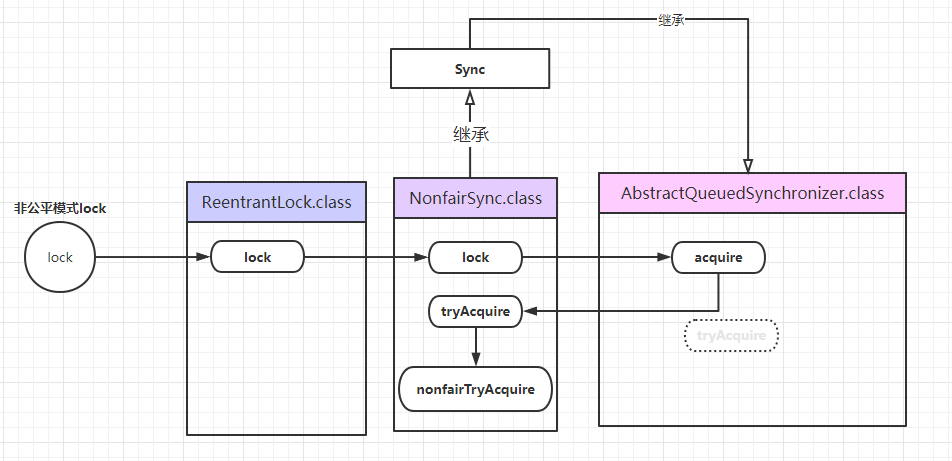之前文章写AQS的时候有说过公平锁的代码 这里以非公平锁来看一下
面试的时候设计模式:模板方法 在AQS里体现的淋漓尽致 ,你要是从设计模式扯到这里,然后你正好又看过AQS在ReentrantLock中的实现,那你就可以让面试官眼前一亮
Lock lock = new ReentrantLock(false);
lock.lock();
/**
* 申请锁
*
* <p>Acquires the lock if it is not held by another thread and returns
* immediately, setting the lock hold count to one.
* 如果没有其他线程持有这个锁,就马上返回,并设置锁持有数为1
* <p>If the current thread already holds the lock then the hold
* count is incremented by one and the method returns immediately.
* 如果当前线程持有锁,就吧持有数量+1(可重入) 然后立即返回
* <p>If the lock is held by another thread then the
* current thread becomes disabled for thread scheduling
* purposes and lies dormant until the lock has been acquired,
* at which time the lock hold count is set to one.
* 如果锁被其他线程持有,当前线程对于调度就不可用,然后睡着, 直到获取锁,然后把锁持有数改为1
*/
// ReentrantLock.class
public void lock() {
sync.lock();
}
// NonfairSync.class
final void lock() {
// 先抢一下(上一篇说的 :小强二话不说先看看能不能跟老板选饼)
if (compareAndSetState(0, 1))
setExclusiveOwnerThread(Thread.currentThread());
else
// 如果没有抢到 再去申请
acquire(1);
}
// AbstractQueuedSynchronizer.class
public final void acquire(int arg) {
// 这个tryAcquire会再抢一次(小强还抱着插队的幻想)
if (!tryAcquire(arg) &&
// 抢不到 就后边排队吧
acquireQueued(addWaiter(Node.EXCLUSIVE), arg))
selfInterrupt();
}
// ReentrantLock.class
protected final boolean tryAcquire(int acquires) {
return nonfairTryAcquire(acquires);
}
// ReentrantLock.class
// 这里需要了解AQS 我其他文章有写 可以去看
final boolean nonfairTryAcquire(int acquires) {
// 获取当前线程
final Thread current = Thread.currentThread();
// 获取state标志位
int c = getState();
if (c == 0) {
// 如果没有线程持有尝试获取锁(小强看见没人跟老板说话 直接插队买饼)
if (compareAndSetState(0, acquires)) {
setExclusiveOwnerThread(current);
return true;
}
}
// 如果有线程持有 看一下是不是自己
else if (current == getExclusiveOwnerThread()) {
// 如果是自己就修改持有数
int nextc = c + acquires;
// 超过最大锁数
if (nextc < 0) // overflow
throw new Error("Maximum lock count exceeded");
setState(nextc);
return true;
}
return false;
}

有什么使用问题或原理问题欢迎留言,或关注公众号:






